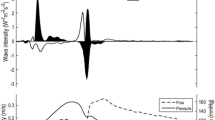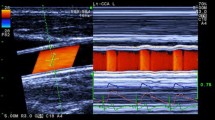Abstract
Wave intensity analysis and wave separation are powerful tools for interrogating coronary, myocardial and microvascular physiology. Wave speed is integral to these calculations and is usually estimated by the single-point technique (SPc), a feasible but as yet unvalidated approach in coronary vessels. We aimed to directly measure wave speed in human coronary arteries and assess the impact of adenosine and nitrate administration. In 14 patients, the transit time Δt between two pressure signals was measured in angiographically normal coronary arteries using a microcatheter equipped with two high-fidelity pressure sensors located Δs = 5 cm apart. Simultaneously, intracoronary pressure and flow velocity were measured with a dual-sensor wire to derive SPc. Actual wave speed was calculated as DNc = Δs/Δt. Hemodynamic signals were recorded at baseline and during adenosine-induced hyperemia, before and after nitroglycerin administration. The energy of separated wave intensity components was assessed using SPc and DNc. At baseline, DNc equaled SPc (15.9 ± 1.8 vs. 16.6 ± 1.5 m/s). Adenosine-induced hyperemia lowered SPc by 40 % (p < 0.005), while DNc remained unchanged, leading to marked differences in respective separated wave energies. Nitroglycerin did not affect DNc, whereas SPc transiently fell to 12.0 ± 1.2 m/s (p < 0.02). Human coronary wave speed is reliably estimated by SPc under resting conditions but not during adenosine-induced vasodilation. Since coronary wave speed is unaffected by microvascular dilation, the SPc estimate at rest can serve as surrogate for separating wave intensity signals obtained during hyperemia, thus greatly extending the scope of WIA to study coronary physiology in humans.








Similar content being viewed by others
References
Alastruey J (2011) Numerical assessment of time-domain methods for the estimation of local arterial pulse wave speed. J Biomech 44:885–891. doi:10.1016/j.jbiomech.2010.12.002
Arts T, Kruger RT, van Gerven W, Lambregts JA, Reneman RS (1979) Propagation velocity and reflection of pressure waves in the canine coronary artery. Am J Physiol 237:H469–H474
Camici PG, Crea F (2007) Coronary microvascular dysfunction. N Engl J Med 356:830–840. doi:10.1056/NEJMra061889
Davies JE, Sen S, Broyd C, Hadjiloizou N, Baksi J, Francis DP, Foale RA, Parker KH, Hughes AD, Chukwuemeka A, Casula R, Malik IS, Mikhail GW, Mayet J (2011) Arterial pulse wave dynamics after percutaneous aortic valve replacement: fall in coronary diastolic suction with increasing heart rate as a basis for angina symptoms in aortic stenosis. Circulation 124:1565–1572. doi:10.1161/circulationaha.110.011916
Davies JE, Whinnett ZI, Francis DP, Manisty CH, Aguado-Sierra J, Willson K, Foale RA, Malik IS, Hughes AD, Parker KH, Mayet J (2006) Evidence of a dominant backward-propagating “suction” wave responsible for diastolic coronary filling in humans, attenuated in left ventricular hypertrophy. Circulation 113:1768–1778. doi:10.1161/circulationaha.105.603050
Davies JE, Whinnett ZI, Francis DP, Willson K, Foale RA, Malik IS, Hughes AD, Parker KH, Mayet J (2006) Use of simultaneous pressure and velocity measurements to estimate arterial wave speed at a single site in humans. Am J Physiol Heart Circ Physiol 290:H878–H885. doi:10.1152/ajpheart.00751.2005
De Bruyne B, Pijls NHJ, Barbato E, Bartunek J, Bech J-W, Wijns W, Heyndrickx GR (2003) Intracoronary and intravenous adenosine 5′-triphosphate, adenosine, papaverine, and contrast medium to assess fractional flow reserve in humans. Circulation 107:1877–1883. doi:10.1161/01.CIR.0000061950.24940.88
De Silva K, Foster P, Guilcher A, Bandara A, Jogiya R, Lockie T, Chowiencyzk P, Nagel E, Marber M, Redwood S, Plein S, Perera D (2013) Coronary wave energy: a novel predictor of functional recovery after myocardial infarction. Circ Cardiovasc Interv 6:166–175. doi:10.1161/circinterventions.112.973081
Hermeling E, Reesink KD, Kornmann LM, Reneman RS, Hoeks AP (2009) The dicrotic notch as alternative time-reference point to measure local pulse wave velocity in the carotid artery by means of ultrasonography. J Hypertens 27:2028–2035. doi:10.1097/HJH.0b013e32832f5890
Hermeling E, Reesink KD, Reneman RS, Hoeks AP (2008) Confluence of incident and reflected waves interferes with systolic foot detection of the carotid artery distension waveform. J Hypertens 26:2374–2380. doi:10.1097/HJH.0b013e328311cdd5
Heusch G (2010) Adenosine and maximum coronary vasodilation in humans: myth and misconceptions in the assessment of coronary reserve. Basic Res Cardiol 105:1–5. doi:10.1007/s00395-009-0074-7
Jones CJ, Kuo L, Davis MJ, Chilian WM (1996) In vivo and in vitro vasoactive reactions of coronary arteriolar microvessels to nitroglycerin. Am J Physiol 271:H461–H468
Kanatsuka H, Eastham CL, Marcus ML, Lamping KG (1992) Effects of nitroglycerin on the coronary microcirculation in normal and ischemic myocardium. J Cardiovasc Pharmacol 19:755–763
Khir AW, O’Brien A, Gibbs JS, Parker KH (2001) Determination of wave speed and wave separation in the arteries. J Biomech 34:1145–1155. doi:10.1016/S0021-9290(01)00076-8
Kinlay S, Creager MA, Fukumoto M, Hikita H, Fang JC, Selwyn AP, Ganz P (2001) Endothelium-derived nitric oxide regulates arterial elasticity in human arteries in vivo. Hypertension 38:1049–1053. doi:10.1161/hy1101.095329
Kleinbongard P, Böse D, Baars T, Möhlenkamp S, Konorza T, Schöner S, Elter-Schulz M, Eggebrecht H, Degen H, Haude M, Levkau B, Schulz R, Erbel R, Heusch G (2011) Vasoconstrictor potential of coronary aspirate from patients undergoing stenting of saphenous vein aortocoronary bypass grafts and its pharmacological attenuation. Circ Res 108:344–352. doi:10.1161/circresaha.110.235713
Kolyva C, Spaan JAE, Piek JJ, Siebes M (2008) Windkesselness of coronary arteries hampers assessment of human coronary wave speed by single-point technique. Am J Physiol Heart Circ Physiol 295:H482–H490. doi:10.1152/ajpheart.00223.2008
Latham RD, Westerhof N, Sipkema P, Rubal BJ, Reuderink P, Murgo JP (1985) Regional wave travel and reflections along the human aorta: a study with six simultaneous micromanometric pressures. Circulation 72:1257–1269. doi:10.1161/01.CIR.72.6.1257
Lockie TPE, Rolandi MC, Guilcher A, Perera D, De Silva K, Williams R, Asrress KN, Patel K, Plein S, Chowienczyk P, Siebes M, Redwood SR, Marber MS (2012) Synergistic adaptations to exercise in the systemic and coronary circulations that underlie the warm-up angina phenomenon. Circulation 126:2565–2574. doi:10.1161/circulationaha.112.094292
Naka KK, Tweddel AC, Doshi SN, Goodfellow J, Henderson AH (2006) Flow-mediated changes in pulse wave velocity: a new clinical measure of endothelial function. Eur Heart J 27:302–309. doi:10.1093/eurheartj/ehi619
Parker K (2009) A brief history of arterial wave mechanics. Med Biol Eng Comput 47:111–118. doi:10.1007/s11517-009-0440-5
Parker KH, Jones CJ (1990) Forward and backward running waves in the arteries: analysis using the method of characteristics. J Biomech Eng 112:322–326. doi:10.1115/1.2891191
Rolandi MC, Nolte F, van de Hoef TP, Remmelink M, Baan J, Piek JJ, Spaan JAE, Siebes M (2012) Coronary wave intensity during the Valsalva manoeuvre in humans reflects altered intramural vessel compression responsible for extravascular resistance. J Physiol 590:4623–4635. doi:10.1113/jphysiol.2012.229914
Savitzky A, Golay MJE (1964) Smoothing and differentiation of data by simplified least squares procedures. Anal Chem 36:1627–1639. doi:10.1021/ac60214a047
Sen S, Escaned J, Malik IS, Mikhail GW, Foale RA, Mila R, Tarkin J, Petraco R, Broyd C, Jabbour R, Sethi A, Baker CS, Bellamy M, Al-Bustami M, Hackett D, Khan M, Lefroy D, Parker KH, Hughes AD, Francis DP, Di Mario C, Mayet J, Davies JE (2012) Development and validation of a new adenosine-independent index of stenosis severity from coronary wave-intensity analysis: results of the ADVISE (Adenosine Vasodilator Independent Stenosis Evaluation) study. J Am Coll Cardiol 59:1392–1402. doi:10.1016/j.jacc.2011.11.003
Seto AH, Tehrani DM, Bharmal MI, Kern MJ (2013) Variations of coronary hemodynamic responses to intravenous adenosine infusion: implications for fractional flow reserve measurements. Catheter Cardiovasc Interv. doi:10.1002/ccd.25305 (in press)
Siebes M, Kolyva C, Verhoeff B-J, Piek J, Spaan J (2009) Potential and limitations of wave intensity analysis in coronary arteries. Med Biol Eng Comput 47:233–239. doi:10.1007/s11517-009-0448-x
Tajaddini A, Kilpatrick DL, Schoenhagen P, Tuzcu EM, Lieber M, Vince DG (2005) Impact of age and hyperglycemia on the mechanical behavior of intact human coronary arteries: an ex vivo intravascular ultrasound study. Am J Physiol Heart Circ Physiol 288:H250–H255. doi:10.1152/ajpheart.00646.2004
Tarkin JM, Nijjer S, Sen S, Petraco R, Echavarria-Pinto M, Asress KN, Lockie T, Khawaja MZ, Mayet J, Hughes AD, Malik IS, Mikhail GW, Baker CS, Foale RA, Redwood S, Francis DP, Escaned J, Davies JE (2013) Hemodynamic response to intravenous adenosine and its effect on fractional flow reserve assessment: results of the adenosine for the functional evaluation of coronary stenosis severity (AFFECTS) study. Circ Cardiovasc Interv 6:654–661. doi:10.1161/circinterventions.113.000591
van de Hoef TP, Meuwissen M, Escaned J, Davies JE, Siebes M, Spaan JAE, Piek JJ (2013) Fractional flow reserve as a surrogate for inducible myocardial ischaemia. Nat Rev Cardiol 10:439–452. doi:10.1038/nrcardio.2013.86
Acknowledgments
The authors gratefully acknowledge the skilled assistance of the catheterization laboratory staff at St. Thomas’ Hospital, London. This study was supported by the Dutch Heart Foundation (2006B186). M.C.R. received a PhD Scholarship of the Academic Medical Center. K.D.S is funded by a Heart Research UK fellowship (RG2593/10/12). D.P. receives financial support from the United Kingdom Department of Health via the National Institute for Health Research Comprehensive Biomedical Research Centre Award to Guy’s & St. Thomas’ National Health Service Foundation Trust in partnership with King’s College London.
Conflict of interest
On behalf of all authors, the corresponding author states that there is no conflict of interest.
Author information
Authors and Affiliations
Corresponding author
Additional information
D. Perera and M. Siebes contributed equally to this work.
Rights and permissions
About this article
Cite this article
Rolandi, M.C., De Silva, K., Lumley, M. et al. Wave speed in human coronary arteries is not influenced by microvascular vasodilation: implications for wave intensity analysis. Basic Res Cardiol 109, 405 (2014). https://doi.org/10.1007/s00395-014-0405-1
Received:
Revised:
Accepted:
Published:
DOI: https://doi.org/10.1007/s00395-014-0405-1




